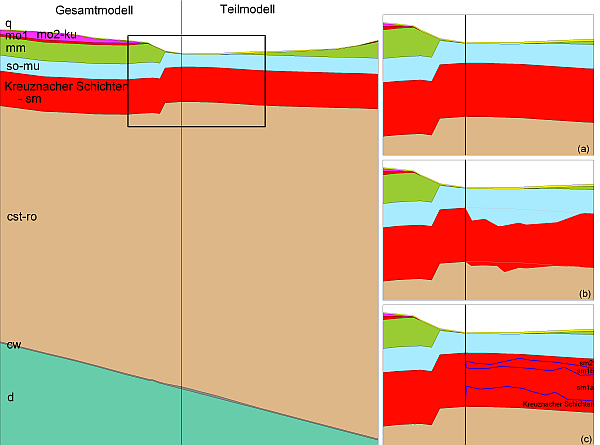Depending on the question and data situation, it may be necessary to make changes to the layer structure of the model when processing a sub-model. The reasons for this may vary:
Recent investigations and drilling results require a change in the depth of layer boundaries.
The processing of detailed questions in the partial model requires a more differentiated consideration of individual geological units, which makes a further subdivision of certain model layers necessary.
A further vertical subdivision of individual model layers is necessary for the correct depiction of e.g. partially penetrating wells or installed construction elements (sheet pile walls, tunnels etc.).
As the layers of the partial model added by the vertical refinement have no equivalent in the overall model, such an assignment must be created when updating the partial model back into the overall model. A distinction must be made between the following cases:
No vertical mesh change has taken place in the partial model. In this case, the boundary nodes on the intersection of the two meshes match and the layer assignment is automatically correct during the feedback. Subfigure (a) of the following figure shows this situation.
In the partial model, the depth of layer boundaries was changed, e.g. due to new drilling data. However, no vertical mesh refinement was carried out, i.e. the number of layers and the assignment between the partial and overall model is identical. In this case, the feedback automatically leads to a correct result. If the height position of layer boundaries on the edge of the partial model has also been changed, the feedback still leads to the correct result. As there is a clear layer assignment, the depth of the layer boundaries on the interface between the models is defined by the imported model part. This means that if you first open the cut-out overall mesh in SPRING and then import the sub-mesh, the depth position of the boundary nodes of the sub-mesh is integrated into the overall mesh. This situation is depicted in subfigure (b).
One or more layers in the sub-mesh have been refined vertically, either to represent a more differentiated geological structure or to take certain conditions (e.g. partially penetrating wells, vertical filter wells, sheet pile walls, tunnels, etc.) into account in a hydraulically correct manner. Such a situation is shown schematically in subfigure (c). In this case, a layer assignment must be carried out during the feedback of the two model parts. In the general case, the vertical refinement is carried out up to the edge of the partial model and the depth position of the layer boundaries present in both models has changed on the edge of the partial model. In this case, an automatic assignment of the model layers is not clearly possible.

Assignment of layers between partial model and overall model at the intersection
In the third case, the number of layers in the partial model changes. The added layer surfaces of the sub-model must be formally present in the overall model after the import, i.e. outside the sub-area where they coincide geometrically with existing layer surfaces. This is controlled during import by the assignment to the boundary nodes of the sub-mesh.
Even if these omitted layers are not actually taken into account in the simulation calculations, they must always be included in the mesh processing and for node and element numbering.
If a further partial model is imported into an overall model in which a vertically refined layer already exists due to an earlier import, as many of the existing coinciding layer surfaces as possible should be used.
Conclusion: In general, the refinement of the layers of the partial model should not be carried out up to the model boundary. This allows the depth of the added layer boundaries towards the model boundary to be meaningfully traced back to the layer boundaries of the overall model.
 Integration of the partial model into the overall model
Integration of the partial model into the overall model
